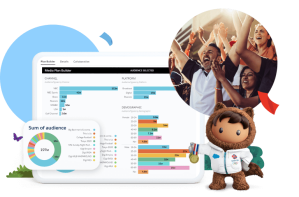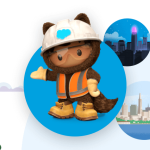Whether it’s elite athletes shaving milliseconds off their lap times or world-leading businesses shortening their sales cycles, there’s a clear link between high performers and the use of data.
For proof of that, look no further than the upcoming Olympic and Paralympic Winter Games Beijing 2022. Every athlete there will be using data as the basis for improving performance.
That was true in 2018, when (to take just one example) Dutch short track skaters used haptic SmartSuits embedded with sensors that allowed coaches to monitor the athletes’ body data in real time.
And it will be true in 2022, where (again to take just one example) the US Ski Team will have prepared to compete using state-of-the-art bibs that track and measure both GPS and technique.
In this blog, we’re going to explore the parallels between how data drives results in athletics and how businesses today are leveraging data through Salesforce to win.
While the two worlds are very different, the fundamental steps are the same: bringing all your data together in one place, getting any data insights into the hands of the relevant people, and focusing on moving the performance needle where it really matters.
Step 1: Bring it all together
Professional athletes in every sport collect reams of data from every conceivable source on a constant basis – including food and nutrition, biometrics (think pulse rate, oxygen levels and sleep rhythms), high-speed motion and positional tracking, video analytics, statistical analysis and wearables.
In isolation, these data sources only present part of the full picture – they’re most powerful when used together.
The same principle applies to modern businesses that collect operational and customer data from a large range of (first and third-party) sources, like your CRM, external ERP, supply chain, HR and on-premises systems.
When siloed, these data sets only offer a partial view of performance. You need full visibility of all the relevant data to make holistically informed decisions that really drive higher performance.
The solution is to bring together and combine all of your data sets to create a “single source of truth” for the business. You can do this using a system integrator like Mulesoft, which uses APIs to connect business systems (including data) and enable greater innovation – and performance.
Once your systems are integrated, you’ll be able to unlock a unified, 360-degree view of your customers – and provide them all with the seamlessly connected, personalised customer experience they want.
In 2020, healthcare solutions provider Simplyhealth kicked off its ‘One Simplyhealth’ digitalisation strategy by building a centralised platform for the business it calls ‘One Salesforce’.
The platform, based on Sales Cloud, Service Cloud, Marketing Cloud and Tableau, was built in just six months, with Simplyhealth’s team using custom APIs to integrate key systems (such as its policy admin system).
Simplyhealth now has a single view of its customers, which is helping it to build stronger relationships with them (and provide its sales teams with more cross-sell opportunities).
Plus, with the company’s data centralised, Simplyhealth’s employees are now able to track KPIs and metrics for rich insights – and make better, data-informed decisions for its customers.
You can read more about how the implementation of the ‘One Salesforce’ platform has enabled a better service experience for over 3 million Simplyhealth customers here.
Step 2: Get the relevant data insights into the right hands
It takes an Olympic Village of coaches, dieticians and psychologists to raise an athlete’s performance to optimal, competitive levels. That’s why consolidating your performance data is just the first step – to really see results, you need to empower the right people to draw cross-functional insights.
For example, in sports, a dietician might need the latest information on a coach’s training regime in order to make adjustments to their athlete’s nutritional intake.
In business, the product team might need to leverage newsletter click-through rates from the marketing team for insights into which topics and features energise customers most.
Salesforce supports your teams to access, analyse and share data insights with each other in a few ways. First, our Customer 360 platform means everyone across sales, marketing, service, commerce, IT or analytics is empowered to bring different data sets together to unlock smarter insights and better decisions.
With Tableau, your teams can easily compare datasets. It gives them access to analytics apps and dashboard templates, making it easy for them to build and share beautiful and insightful dashboards.
And sharing these data-driven insights without disturbing workflows is easier than ever thanks to Tableau’s integration with Slack, which helps put data at the heart of intra and cross-departmental conversations.
At Coca-Cola European Partners (CCEP), the largest independent bottler of Coca-Cola beverages, the implementation of Tableau Desktop and Server has fostered a data-centric culture throughout the company’s workforce.
By enabling CCEP to analyse a wide range of disparate data sources through a single platform, Tableau has enabled faster, more accurate and more accessible reporting than its previous, outdated manual tools.
CCEP’s Strategy and Insights team can now publish live dashboards and reports across the entire organisation at the touch of a button – and employees feel confident in using this data, knowing that it’s up-to-date and error-free.
This newfound confidence in data has led to data analytics taking on increased importance across numerous of the company’s key departments – and the company’s employees increasingly looking to self-serve their own analytics needs.
As CCEP’s Strategy and Insights Manager Johannes Sæthre says: “When people learn to interact with data and use it more in their daily activities, it becomes insanely impactful.”
You can read the full story here.
Step 3: Focus on the improvements that matter
Athletes use data analytics (complemented by AI) to continuously identify areas where they can make so-called ‘marginal gains’ in their training and preparation processes. The idea is that incremental improvements in a multitude of areas can add up to a winning edge.
Athletes win with marginal gains because each sport is mature discipline – you need to perfect minutiae to win. But in business, the opportunities for data-driven performance are so numerous that many organizations quickly get overwhelmed.
Businesses can win with marginal gains by thinking more in terms of small, achievable, incremental data wins. This approach quickly outperforms large-scale projects that crumble under their own weight.
Many of our customers have kicked off sweeping transformation projects by starting with smaller, focused initiatives.
Santander UK, for example, kicked off a huge, multi-year digital transformation programme by using cloud-based SaaS solutions (including Salesforce) to digitise its onboarding journey for corporate and commercial customers – reducing account opening times by 80%.
Following the success of this focused initiative, Santander used the same SaaS ecosystem to transform its multi-billion pound corporate and commercial lending operation – which was previously split across 13 disparate systems and involved a number of manual processes.
Leveraging the nCino Bank Operating System (built on Salesforce), Santander digitised, automated and significantly accelerated its lending process for corporate and SME customers.
This digitisation turned out to be vitally important in helping the bank cope with the huge spike in demand for commercial lending caused by the COVID-19 pandemic in 2019 – and in helping SMEs, in particular, weather the storm.
Under the UK government’s Coronavirus Business Interruption Loan Scheme, Santander saw tens of thousands of loan requests pour in from small businesses in just a couple of weeks.
Fortunately, the bank now had Sales Cloud in place to log, categorise and track these requests. Salesforce also helped Santander cope with a massively increased demand for capital repayment holidays – which rose from an average of 50 per week to 500 during the pandemic.
You can read the full story here.
Athletics and business: a winning team.
Businesses can learn a lot from athletics – and that doesn’t stop with following in their footsteps to boost performance.
At its best, sport unites people, often across international boundaries. We think that’s what businesses should do, too.
At Salesforce, we’re on a mission to bring companies and customers together, wherever they are. That’s why we’ve formed a partnership with our national, nation-uniting Team GB.
To find out more about our partnership – and the lessons businesses can learn from both the success and spirit of Team GB, head to our Team GB partnership page.
























